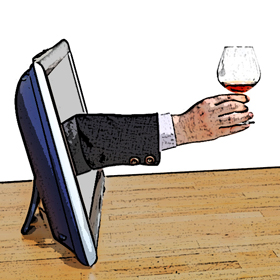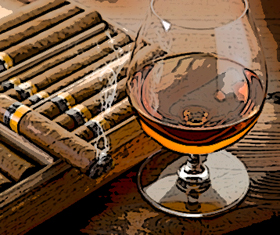A Lesson In How To Smell Better.
Chapter Three, Part Seven.
 Late in 1993 an ENT specialist assured me that sinus surgery would not affect my sense of smell. He lied.
Late in 1993 an ENT specialist assured me that sinus surgery would not affect my sense of smell. He lied.
Months after the surgery I still couldn’t smell which was a little disconcerting since I was about to make wine sniffing my life’s work. I felt like Manny Ramirez facing Mariano Riviera in the bottom of the ninth – minus the steroids.
The surgery made my sense of smell spotty and inconsistent which made analyzing wine difficult. I had to get my schnoz back in shape so I sent it to basic training snoot camp. I’d go to a wine tasting and smell every wine in the room. When I had a snoot-full and thought about quitting I’d hear this drill sergeant in my head screaming, “Come on Carter! Gimme 50 more! You can do it ya pussy! Sniff that Beaune, smell that Pfalz!” Within a year I probably stuck my nose in 10,000 wine glasses, which wasn’t nearly as much as I stuck it in other people’s business. The work paid off and today my nose runs constantly.
Smelling had once come to me as naturally as say, smelling. In the course of relearning how to smell I became a student of perception and tasting techniques. When industry leaders came to call I’d pick their brains about the secrets of sensory perception and the tools they used to enhance those perceptions. Believe me, I’ve shared many bottles with leading authorities in the wine and spirits trade. When I drink, I like to drink with authority.
One such authority was Alain Braastad-Delamain, President Directeur General of the venerable House of Delamain. This distinguished Cognac producer has been making exceptional brandies since 1759, and 240 years later Delamain finally got around to paying me a visit. Coincidentally, in the aftermath of our meeting Cognac sales in America skyrocketed.
I’m just saying.
The afternoon Alain stopped by my wine shop I learned an important lesson regarding nosing techniques. Although his tutorial regarded smelling a spirit rather than wine, I think it bears repeating as it illustrates how minute factors can alter the subtleties of any aroma.
Alain explained that unlike wine, there’s no need to vigorously swirl Cognac then thrust your nose into the glass and take a deep sniff. Inhaling a spirit like this can anesthetize your senses, making further distinctions difficult.
Because Cognac is high in alcohol, evaporation begins as soon as it comes in contact with air. I remind my wife of this when she asks why the Cognac in our house disappears so quickly.
Cognac glasses have a large bowl to collect vapors and a narrow top to funnel the rising aromas towards your nose.¹ Start your analysis by gently inhaling the air two inches above the rim and gradually move the glass  closer to your nose. The aromas evolve as they merge with air, so an astute observer will notice how the aromas two inches above the glass are different from the aromas at the rim of the glass. Once your nose is fully ensconced inside the bowl you will discover the aromas have changed again.
closer to your nose. The aromas evolve as they merge with air, so an astute observer will notice how the aromas two inches above the glass are different from the aromas at the rim of the glass. Once your nose is fully ensconced inside the bowl you will discover the aromas have changed again.
To accurately analyze and appreciate brandy you mustn’t spit it out (duh!) because when you swallow, your closed mouth forces you to exhale through your nose. As the vapors rise through your retro-nasal passage, they re-stimulate your sense of smell and contribute to the aftertaste.
Sampling several brandies without the benefit of a spittoon can make it hard for the amateur drinker to remain sober in these situations. I, on the other hand, am a trained professional. I am not affected when I brink drandy.
Eighteen years after spending an afternoon with Monsieur Braastad-Delamain, his son Charles expressed a desire to meet when he visited America. We too, spent an afternoon at my store and when we sat down to taste his Cognacs I opened my tasting book to the page where I had made my notes 18 years earlier with his father. My new notes were remarkably similar to the original impressions but I did pick up some additional traits that I’ve included in italics in my reviews below.
So in the end my ENT specialist was right. My sense of smell did clear so I decided to send him a check that would also clear. The tasting techniques I learned from a master Cognac producer have come in handy and not just when I’m nosing a spirit. Try Alain’s technique the next time you stick your nose in a glass, any glass, and you too will smell better.
Delamain, Pale & Dry, Cognac, 100% Grand Champagne, 25 years old.
The nose features a faint vanilla bean aroma which deepens into walnut as your nose gets closer to the glass. In the second tasting I picked up fruitier notes of orange peel. The palate is extremely delicate, light to medium in weight, with a smooth personality that’s as flowery and spicy as a night at the Moulin Rouge and as airy as a performance by Le Pétomane.² The fruit characteristics rise in the aftertaste and blend with a subtle hint of licorice.
Rating:  (4 / 5)
(4 / 5)
Delamain, Vesper, Cognac, 100% Grand Champagne, 35 years old.
The walnut and vanilla aromas found in Vesper are more pronounced than in the Pale & Dry and the aromas are at once both rounder and sweeter. There’s a honeyed, caramelized, molasses-like sweetness³ that wasn’t as easily discerned years ago, as well as more noticeable fruit scents of ripe pear and orange. The palate is very full and smooth, with a glycerin-rich, creamy fatness that the Pale & Dry lacks (deliberately). Some of the spiciness is still present, but it leans towards sweet Christmas spice. Charles declared this Cognac “cigar-friendly” but, ever the skeptic, I lit up a Cohiba to be sure.
Rating:  (4.5 / 5)
(4.5 / 5)
Delamain, Tres Venerable, Cognac, 100% Grand Champagne, 55 years old.
Sublime and subtle best describes the aromas, texture and flavors of Tres Venerable Cognac. Nuanced with delicate nutty scents that combine with equally restrained notes of sweet spice and orange. This Cognac is extremely smooth. I mean it’s smooth like a horny Frenchman set loose in a Pilates’ classroom. It manages to come across as both delicate and richly round in the mouth. Alain suggested I sniff my empty glass and doing so revealed pronounced oak aromas that weren’t obvious earlier.
Rating:  (4.5 / 5)
(4.5 / 5)
¹Delamain’s literature states, “Large “balloon” glasses are unsuited for serious Cognac-tasting, for they release the brandy’s fragrance too violently-with the immediate effect of paralyzing one’s sense of smell.”
²A regular performer at the Moulin Rouge, Le Pétomane was a renowned flatulist, a farteur, a true fartiste.
³Unlike some Cognac producers, Delamain does not put any caramel (sugar) in its Cognac.






















